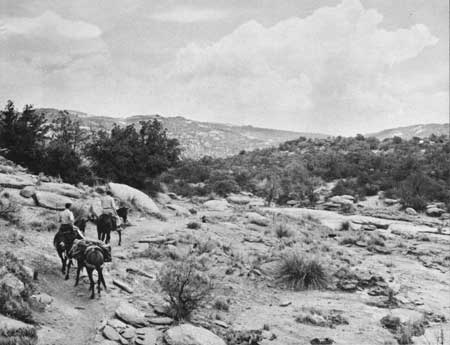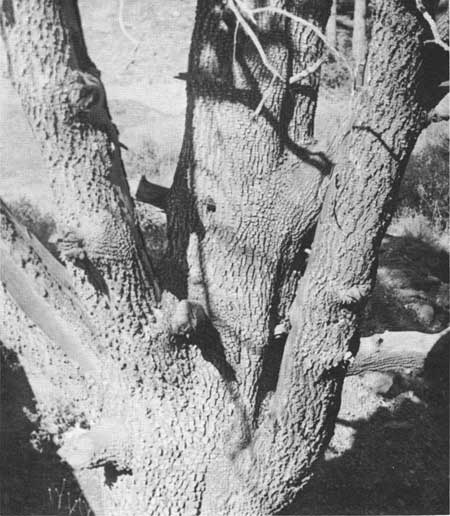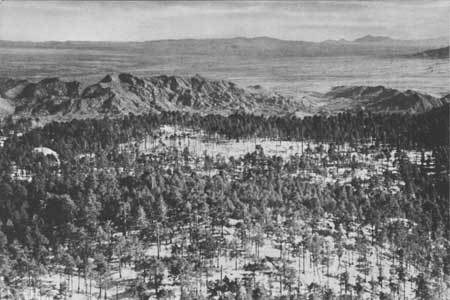|
SAGUARO National Park |
 |
Life Zones Represented in the Monument
In journeying northward across the Americas from the equator to the polar ice cap, biologists have recorded seven major belts, or zones, of plant and animal life. These have been called life zones and given names descriptive of the parts of the continent in which they reach their greatest development: Tropical, Lower Sonoran or Austral, Upper Sonoran, Transition, Canadian, Hudsonian, and Arctic. Of outstanding interest is the fact that these life zones may occur locally within fairly definite elevation limits in mountain ranges. This similarity between latitudinal changes in plant and animal life near sea level and a variety of elevations at the same latitude has been expressed in the life zone concept. Its application in Saguaro National Monument is illustrated by the fact that in climbing from the Cactus Forest at about 2,600 feet to the top of Mica Mountain at nearly 8,600 feet you may readily recognize many of the plants and animals that you would meet in traveling northward 1,500 miles from the State of Sonora, Mexico, to the Provinces of southern Canada. Thus, in a trip of some 6,000 feet up the mountain within the monument you encounter plants and animals of the Lower Sonoran, Upper Sonoran, Transition, and Canadian Life Zones. These life zones within the monument are illustrated in the tabulation on the facing page.
VEGETATIVE COVER TYPES IN SAGUARO NATIONAL MONUMENT
(Adapted from A. A. Nichol, "Vegetation of Arizona")
| COVER TYPE | JULY AVER. TEMP. |
ELEVATIONS | ANNUAL RAINFALL |
PROMINENT SPECIES | LIFE ZONE |
| ° F. | Feet | Inches | |||
| Arizona Microphyl Desert | 94 | Below 3,000 | 3 to 11 | Creosotebush Saltbush Needle grama-grass Indian wheat |
LOWER SONORAN |
| Succulent Desert | 94 | 3,000 to 3,500 |
3 to 11 | Prickly pear Cholla Saguaro Palo verde Bur-sage Catclaw Ocotillo Mesquite | |
| Grasslands | 85 | 3,500 to 5,000 |
12 to 16 | Curly mesquite grass Emory oak Tobosagrass Gramagrass Agave (century plant) |
UPPER SONORAN |
| Chaparral | 82 | 5,000 to 7,000 |
14 to 18 | Jumper Pinyon Algerita Scrub oak Mountain mahogany Sumac Manzanita Bluestemgrass Tobosagrass | |
| Forest | 68 | Above 6,000 |
21 to 35 | Gambel oak Ponderosa pine Mountain muhly Douglas-fir White fir Spruce Aspen Snowberry Buckbrush New Mexico locust |
TRANSITION and start of CANADIAN |
Overlaps in the foregoing tabulation indicate that there are no sharp dividing lines between life zones, the typical plants of one zone blending with those of another zone quite gradually. Steepness of slope, angle of exposure to the sun at various times of day and season, and the type of soil have important bearing on the kind of plants which can survive even at a given elevation. For example, aspens and Douglas-firs indicative of the Canadian Life Zone extend down the cool north slopes of Mica Mountain and Rincon Peak to elevations occupied by pinyons and junipers of the Upper Sonoran Life Zone on the hot, dry southern face of nearby Wrong Mountain. Elevation figures expressing the life zone concept thus are simply averages or approximations which are helpful as guides to persons on the lookout for the plants and animals that serve as markers or indicators of these vegetation and animal zones. Until a road is built into the Tanque Verde and Rincon Mountains, the back country containing examples of the Transition and Canadian Life Zones will remain accessible only by foot or horse back. Several well maintained horse trails lead from both the west and east sides of the Rincons to the crest of the range.
PLANTS OF THE UPPER SONORAN LIFE ZONE
The thinning and final disappearance of saguaros from along the trailside, although mesquites and ocotillos seem almost as numerous as on the floor of the desert, indicate that you are leaving the Lower Sonoran and entering the Upper Sonoran Life Zone. An occasional EMORY OAK (Quercus emorii) and NETLEAF HACKBERRY (Celtis reticulata) appears among the mesquites along the washes. Ground cover includes galletagrass, the gramas, curly mesquitegrass, clumps of snakeweed, rabbitbrush, and a variety of herbs.
A spectacular inhabitant of the grasslands and oak woodlands of the Upper Sonoran Zone is the AMOLE (Agave schottii), also called AGAVE or CENTURY PLANT, whose rapidly growing blossom stalks attract attention from May to as late as August. The plants themselves, which grow crowded together in patches, consist of rosettes of succulent leaves superficially resembling bunches of flattened, green bananas. Stiff leaf tips are needle-sharp and can inflict a painful jab to man and beast. During its lifetime, the plant stores food in its short, thick stem. Finally after several years it sends up an unbranched flower stalk that grows 5 to 9 feet high. The light-yellow flowers mature to brown capsulelike fruits, after which the plant dies. The short stems or crowns containing saponin were used by Indians as soap. They also roasted the young bud stalks of some species by covering them with heated stones in pits.
Two noticeable plants of the lily family which sometimes dominate gravelly slopes of the grassland-woodland belt are the SOTOL (Dasylirion wheeleri) and SACAHUISTA, or BEARGRASS (Nolina microcarpa). The former grows from a compact crown as a dense, rather symmetrical, cluster of long, thin, ribbonlike leaves, usually frayed at the tips and armed along the margins with curved thorns. In early summer many small cream-colored blossoms develop along the upper extremity of single fast growing flower stalks 8 to 10 feet high. The bud stalks formerly were harvested and roasted by Indians. In Mexico a powerful alcoholic drink, sotol, is distilled from the fermented juice of the pounded crowns. Sacahuista resembles huge sprawling clusters of coarse grass. Flower stalks are short, producing conspicuous, open, loose sprays of small, tan to brownish flowers in May and June. Indians used the tender bud stalks for food and obtained fiber from the long, slender leaves, weaving them into baskets and mats.
 The Rincons where grassland and chaparral merge with pinyon-juniper woodland of the Upper Sonoran Life Zone. |
Although a close relative of poison ivy and sumac, the aromatic foliage of SKUNKBUSH (Rhus trilobata) is harmless. Growing in compact thickets, often with scrub oak and other types of chaparral, skunk-bush provides food and cover for birds and small animals. Inconspicuous yellow flowers appear from March to June, followed by berrylike fruits which are dull red when mature.
Especially abundant on the lower eastern flanks of the Rincon Mountains in the Happy Valley area, is POINTLEAF MANZANITA (Arctostaphylos pungens) which forms thickets on dry slopes. Early in spring the waxy, urn-shaped blossoms, the leathery, glossy, evergreen leaves, and the typical grotesquely crooked, red-barked limbs, make manzanita one of the attractive shrubs of the chaparral belt.
Two trees worthy of mention, although rare in the monument, are the ARIZONA SYCAMORE (Platanus wrightii) and the ARIZONA CYPRESS (Cupressus arizonica). They are sometimes found growing together along canyon watercourses such as Chiminea Wash and Rincon Creek which drain south from Cow Saddle and the rugged back country between the Rincons and the Tanque Verdes.
As you continue to climb, open, grassy, shrub-dotted slopes gradually give place to sprawling thickets of chaparral. These are made up of manzanita and skunkbush, SILKTASSEL (Garrya wrightii), with scrub oak and underbrush of smaller shrubs. Among the common oaks are the ARIZONA WHITE OAK (Quercus arizonica), SILVERLEAF OAK (Quercus hypoleuca), SHRUB LIVE OAK (Quercus turbinella), and emory oak. They furnish protective cover, browse, and acorns for deer and other mammals and birds, and are of great value in retarding soil erosion on steep, gravelly slopes. As you follow the trail higher, occasional MEXICAN PINYON PINE (Pinus cembroides) and ALLIGATOR JUNIPER (Juniperus pachyphloea) appear. Gradually these evergreens become more abundant, chaparral merging almost imperceptibly with the pigmy forest of pinyons and junipers. Clumps of MOUNTAIN-MAHOGANY (Cercocarpus breviflorus) are noticeable, their feathery seed "tails" gleaming in the sunshine.
Pinyons are among the commonest and most widespread trees of the middle elevations throughout the Southwest. The Mexican pinyon, which is the species growing abundantly in the Tanque Verde-Rincon upland of the monument, may be recognized by the fact that its foilage is in clusters of three needles to the group or bundle. Its cones require nearly 2 years to mature and contain hard-shelled seeds or nuts which are a source of food for many kinds of birds and mammals. The trees are usually shrubby, rarely more than 15 to 25 feet high, with horizontal, twisted, low-growing limbs. Intermingled with the pinyons are occasional junipers, often mistakenly called cedars. Those in the monument are conspicuous because of their platy bark forming an attractive pattern somewhat resembling the squarish-scaled skin of alligators. The berrylike cones are soft and mealy, and are eaten by many forms of wildlife.
Although the pinyon-juniper woodland supports a heavy stand of shrubby trees over much of the terrain there are numerous open glades and grassy hillsides. BLUEGRASS (Poa fenleriana) and VINE MESQUITEGRASS (Panicum bulbosum) furnish ground cover. Following summer showers, many flowering herbs brighten the open slopes.
Yellow to orange petals of PUCCOON (Lithospermum multiflorum), the white to lavendar and rose blossoms of MOCK-PENNYROYAL (Hedeoma hyssopifolium), BEEBALM (Monarda austromontana), and HOUSTONIA (Houstonia wrightii) are among those seen along the trailside.
 A platey bark pattern helps to identify the alligator juniper tree. |
PLANTS OF THE TRANSITION LIFE ZONE
Just as grassland merges with chaparral, and chaparral with pinyon juniper woodland, so you will notice as you climb steadily higher, that these woodlands gradually mingle with the open pine forests that cover much of the Rincon Mountains above 6,000 to 7,000 feet. PONDEROSA PINE (Pinus ponderosa) is the "big tree" of the Rincons, growing in clear, open stands. Its high canopy of spreading branches allows sunlight to mottle the shaded forest floor. Its presence indicates the prevalence of conditions associated with the Transition Life Zone.
Except for grasses such as FESCUE (Festuca sororia), MOUNTAIN MUHLY (Muhlenbergia montana), and BLUE GRAMA (Bouteloua gracilis), ground cover is scarce. However, in tree-glades or on old burns, intermediate-type shrubs such as BUCKBRUSH (Ceanothus fendleri) and herbs have established themselves. Some of these herbs develop into patches of colorful flowers in summer and autumn. Common flowering plants found among the pines are COLOGANIA (Cologania lemmoni), PEAVINE (Lathyrus graminifolius) with its large and showy, white sweetpea-like blossoms throughout the summer, lupines, DOGBANE (Apocynum androsaemifolium). and the well-known white WESTERN YARROW (Achillea lanulosa). Here, too, may be found LARKSPUR (Delphinium sp.), GROUNDSEL (Senecio neomexicanus), ASTER (Aster commutatus), FLEABANE (Erigeron arizonicus), and others often brightened by the presence of butterflies and other insects seeking nectar and pollen. Most of these forest flowers bloom in the late summer or autumn when plants in the desert, far below, are drab and dormant.
Throughout the pine forests, numerous small canyons and rocky outcrops favor the development of thickets of oak and locust, frequently growing together. GAMBEL'S OAK (Quercus gambelii), a leaf-shedding, white oak, ranges in size from a small shrub to a handsome tree. It has broad, deeply lobed leaves which provide browse for deer. Its acorns are consumed by deer, rodents, and birds, including wild turkeys. The NEW MEXICAN LOCUST (Robinia neomexicana) also is browsed by deer. Rarely reaching tree size, this species is an attractive addition to the vegetative cover with its odd-pinnate leaves and large clusters of purplish-pink flowers that appear in May and June. Locust sprout freely from roots and form expanding thickets which encroach upon oak clumps. They provide a valuable network of soil-holding roots, important in retarding erosion.
Relatively few in number, compared with the stands of the dominant ponderosa pine, the smaller CHIHUAHUA PINE (Pinus chihuahuana) grows on dry slopes and benches. Its needles are shorter than those of the ponderosa pine, and its cones are conspicuously persistent, remaining on the tree for several years. This Mexican species invades the United States among the mountain ranges of southern Arizona and southwestern New Mexico. In the monument it is found along the border line between the Upper Sonoran and Transition Life Zones.
 Ponderosa pines in open stands cover much of the Rincon Range above 6,000 feet. |
A cone-bearing tree growing with the ponderosa pine, especially on higher northern and northeastern slopes of Mica Mountain, is the WHITE FIR (Abies concolor). It is also found with stands of Douglas-fir and southwestern pine. Flattened, gray-green needles curving upward from the branches, and large, green cones growing upright on limbs near the tops of the trees identify this beautiful evergreen. In open stands, the branches of even the large trees extend close to the ground. Bark is gray or ash colored. An occasional Arizona cypress may be found by the careful observer hidden among the larger white firs and Douglas-firs.
PLANTS OF THE CANADIAN LIFE ZONE
The Rincon Mountains are not high enough to provide a Canadian Life Zone habitat except in a few favorable locations. Such areas as the north slopes of Mica Mountain and Rincon Peak support small stands of trees and lesser plants typical of the borderline between the Transition and Canadian Zones. At the highest part of the Rincons, ponderosa pines dominate in the warmer, exposed locations, but white-barked QUAKING ASPENS (Populus tremuloides) grow in pure stands on cooler slopes near Spud Rock Ranger Station or with DOUGLAS-FIRS (Pseudotsuga menziesii) on the north side of the Rincon Peak. West of Spud Rock are abundant small groves of SOUTHWESTERN WHITE PINE (Pinus reflexa), a close relative of the limber pine and also of the Mexican white pine, which attest to the elevation but remind the observer that he is close to the southern border of the United States.
BRACKEN (Pteridium aquilinum) forms a green ground cover in heavy stands of pine and fir. This fern grows 3 feet high over much of the cooler, forested Rincon highland. Among the shrubs found on the mountaintop is the SNOWBERRY (Symphoricarpos oreophilus) whose leaves are browsed by deer and whose berries are eaten by birds and chipmunks.
A spring, a small mountain stream, and a meadow near Manning Camp complete the picture of the higher elevations in the monument. In this bit of meadowland are found NEW MEXICAN ALDER (Alnus oblongifolia), CINQUEFOIL (Potentilla subviscosa), CHOKECHERRY (Prunus melanocarpa), GOLDENROD (Solidago sparsiflora), ORANGE SNEEZEWEED (Helenium hoopesii), MARIGOLD (Tagetes lemmoni), WILLOW (Salix sp.), and a number of other shrubs, grasses, and herbs characteristic of the high mountain meadows of the Southwest.

|

|
|
|
|
Last Modified: Sat, Nov 4 2006 10:00:00 pm PST |


